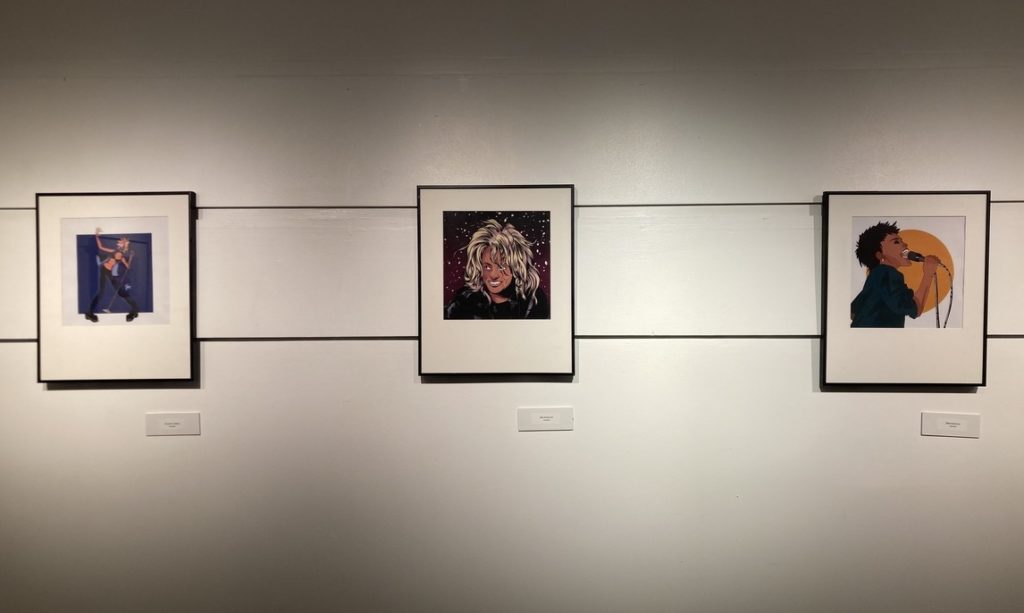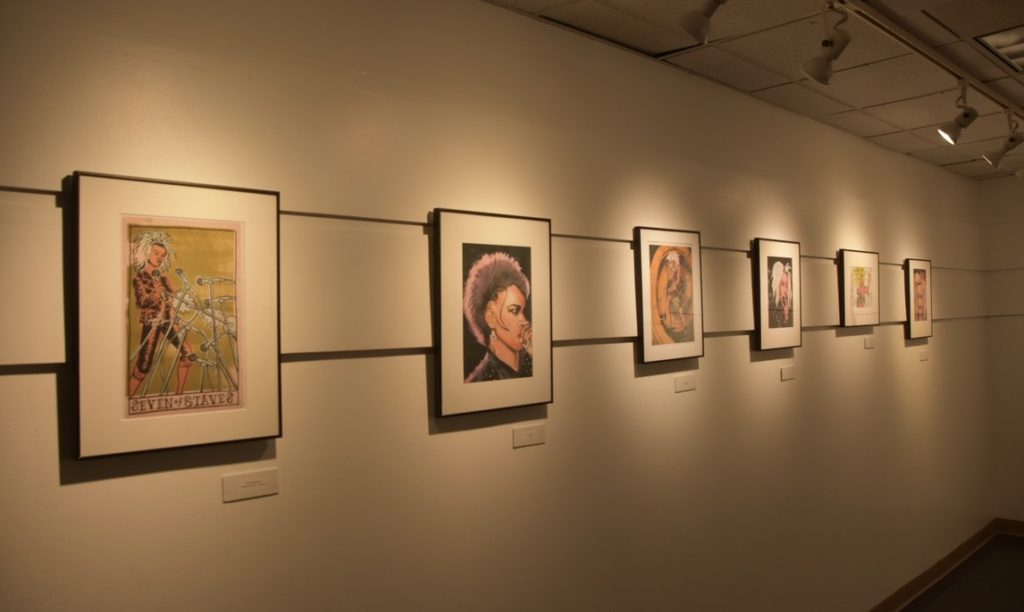In the annals of music history, some voices echo through time, shaping entire genres and movements. Yet, there are also those whose voices, despite their undeniable talent and influence, have been muffled by the forces of intersectionality.
Tina Bell, a Black woman navigating the predominantly white, male-dominated landscape of the 1980s music industry, stands as a prime example of how gender and race can often lead to the erasure of key figures from conversations where they rightfully belong. Bell’s band, Bam Bam, laid the groundwork for a genre that transcended boundaries and defied conventions. Despite her pivotal role in shaping the grunge movement, her name has remained largely absent from mainstream narratives, relegated to the shadows of history.
In addressing that erasure, an exhibition in the heart of Seattle’s vibrant art scene emerges at Seattle Central’s M. Rosetta Hunter Gallery, “QUEEN OF GRUNGE: Portraits of Tina Bell.” Curated by Meghan Trainor and supported by the Equity, Diversity, Inclusion, and Community (EDIC) office, the showcase aims to rectify historical erasure and celebrate Bell’s groundbreaking contributions to music.

Reviving a Pioneer
Collaborating with the EDIC, Trainor spearheaded the initiative to spotlight Bell for Black History Month. Trainor’s efforts were supported by those of Scotty ‘Buttocks’ Ledgerwood, Bam Bam’s bass player, who helped bring Bell’s story to the forefront by providing access to most of the show’s artworks.
Aside from artwork, the exhibit includes videos of Bell and Bam Bam. Trainor explained, “I wanted to show videos because I think they really helped encapsulate what time we’re in.” The decision reflects Trainor’s appreciation for new media’s ability to capture the essence of an era.
Awakening Awareness
Mikaila Harris, director of EDIC, underscores, “The objective of this exhibition is in perfect alignment with the office while acknowledging that there’s still so much more progress to be made.” Harris articulates, “We want to make sure that we are supporting all of our marginalized identities, addressing those intersections, and highlighting how we still have a long way to go.”
Trainor elaborated on the significance of the exhibition’s title, stating that designating Bell as the “Queen of Grunge” challenges misconceptions about Seattle’s music history. By bestowing this title upon Bell, Trainor believes it disrupts the notion that the narrative of the Seattle sound is fully understood. “The exhibit as a whole is really to bring awareness to who she was, to position her in the culture of Seattle. This woman deserves an exalted place in the history of Seattle. The city is so aligned with the grunge sound, yet her music and band were predictably written out of history because she didn’t fit the mold,” says Trainor.
Amelia Light, a work-study student, reflects on her journey of discovery regarding Bell’s significance within the grunge movement. Light admits, “I didn’t know who Tina Bell was before all this. As far as I knew about grunge, it was Nirvana, all those people.” However, Light’s involvement in setting up the exhibition has broadened her perspective and prompted her to seek out musicians exploring new sounds from diverse backgrounds.
Regarding the exhibition’s impact on her understanding of grunge, Light emphasizes its role in breaking down musical boundaries. She observes, “I think that grunge, in general, freed many people from the idea that music has to be a certain way.” Light credits Bell and the grunge movement for pioneering this shift, noting, “Tina Bell and grunge was kind of the start of that because it mixes rock and roll with their new sound. It blurs the lines of music, which I think is beautiful.”

Inspiring Reflection and Action
Trainor expresses a sincere desire, “I would love for people to learn more about Tina Bell than we have provided here.” Meanwhile, Harris envisions the exhibition sparking curiosity among attendees, urging them to ponder not only Bell’s historical contributions but also the current state of the music scene in Seattle. Harris hopes visitors will consider whether people of color receive adequate support from the broader community.
Harris wants people to understand the significance of highlighting Bell as a Black woman and a Black frontwoman. However, she also stresses, “Even if you don’t hold those identities, there’s still something to learn. There are many ways that the music scene, or even the art scene, shadowbans particular perspectives, ideas, and identities.” Thus, there is a broader imperative to address systemic biases in the music and art industries and the importance of recognizing and celebrating diverse perspectives. “There is progress to be made. There is something that we can all do to readjust our perspective and to confront the status quo that we aren’t as conscious of,” says Harris.
Ultimately, Trainor and Harris envision the exhibition as more than just a tribute to Bell’s legacy; they see it as a catalyst for introspection and advocacy toward a future characterized by greater inclusivity.
Ensuring a Lasting Legacy
Trainor envisions a grand tribute to Bell’s legacy, aiming for a large-scale mural on the campus, possibly placed in a prominent outdoor location. Additionally, Trainor desires to see a statue of Bell erected on the South Lawn, directly across from the iconic figure of Jimi Hendrix. She believes such tangible commemorations will solidify Bell’s enduring impact.
Trainor anticipates these landmarks will draw visitors from around the globe, paralleling the interest in iconic sites such as Kurt Cobain’s house. She expresses optimism that these endeavors will become sources of pride for the college, aligning “Not just the gallery’s mission, but the college’s mission” to champion diverse voices and histories (Register here to support and gain further insight into these forthcoming initiatives).
The “QUEEN OF GRUNGE: Portraits of Tina Bell” exhibition (Open until February 29, 2024, Monday through Thursday from 10 am to 3 pm) serves as a powerful act of reclaiming forgotten narratives, amplifying marginalized voices, and paving the way for a more inclusive future in the realm of music and beyond.







Be First to Comment